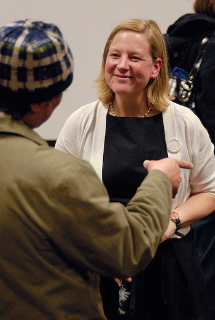MFA exhibit focuses on America, land of junk food
February 4th, 2010 Posted in OpinionStory by Latashia Redhouse
Photo by Cody Gochnour
LOGAN–Artist Holly Johnson hopes her new exhibit is dangerous to your diet and to America’s consumptive culture.
Johnson, a master of fine arts student at Utah State University, presented her vision of America’s fixation on food at an opening reception and  lecture in Studio 102 in the Fine Arts Center last week. “Place and Product: Exploring America’s Food Rituals” is Johnson’s challenge to American’s eating habits.
lecture in Studio 102 in the Fine Arts Center last week. “Place and Product: Exploring America’s Food Rituals” is Johnson’s challenge to American’s eating habits.
The exhibit “represents the concerns and fascination of America’s ‘fast,’ ‘easy,’ and ‘to-go’ lifestyles,” Johnson said.
Upon entering the exhibition, visitors arrive at a place of junk food galore, where pure white shelves are lined with rainbowed colors of America’s favorite snacks that tease our gluttony. Prayer flags hanging from a hula hoop display digital photos of farm landscapes, corn fields, plastic trash, lunchables and more.
A lonely dinner table, set with plaster molds of corn, cups and painted bowls and plates, is devoid of dinner dialogue and the tempting aromas and sight of “homemade food.” Instead, shimmering silverware and a tiny tractor are the only objects that give life to the scene of the abandoned American foodscape.
In the “Single-Serve Nation,” as in Johnson’s exhibit, life centers around white molded-plastic single-serve food containers.
A bar-coded flag waves in the faintest breeze above a puddle of black ooze filled with plastic pellets, to-go cups, soda bottles, and discarded plastic lids, ranging from an 8-oz. Coke bottle to a 100-oz. Super Double-Double Gulp container.
A film projects a drive down Logan’s Main Street and a quick stop at the Sonic drive-thru. A computer screen displays consumption facts, with plaster molds of to-go containers and lunchables surrounding its base. An antique living room setting gives a warm and cozy feeling, except for the plaster molds of a lunch tray, suggesting the emptiness of modern American nutrition and eating habits.
“My work exams the patterns that exist between land and its development, juxtaposed with the production, consumption and packaging of what we eat and drink,” Johnson says.
Although America’s over-consumption is stunning, it’s not too late to prevent the growth of landfill trash and pollution, she said.
Johnson’s project grew from her own desire to break free of what is generally accepted as life in modern America, she said. One day she decided that her life needed greater meaning, and her exhibit is an effort to extend that meaning to others.
“I want to be an inspiration, but I don’t want to change you,” she told an audience at her exhibit opening. “I just want you to have a perspective.”
The spread of America’s consumption culture helped give Johnson perspective and to see the world differently. Her travels abroad taught her how American products and everyday objects influence culture.
In one poor neighborhood in India, she said, an Indian man couldn’t grasp the concept of a lint roller. She remembers seeing a child playing with a car fashioned from a plastic water bottle, and an Asian woman who used so much laundry detergent that bubbles swallowed her. These kinds of images have changed her world perspective, as well as her sense of her own place on the planet.
The artist urges others to take the same hard look at the world and at themselves. “Try not to use plastic,” Johnson pleaded.
Johnson’s exhibition is housed in Studio 102 of the Chase Fine Arts Center until Feb. 5 and is open to the public free of charge.

Sorry, comments for this entry are closed at this time.